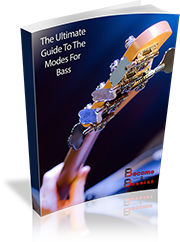I got an email a few weeks ago from an email subscriber asking about an advanced bass improv concept – playing ‘outside‘ the established harmony.
This is very much an advanced topic. If you’re still in the process of learning how to improvise using scales and modes, keep at it. You can even use my free guide to the modes. If you have more experience though and you know you’re ready, keep reading.
Playing ‘outside’ means you play notes that don’t fit in the key that you’re using. How is this different from playing ‘wrong’ notes? Well, it’s in the resolution of the outside notes. The outside notes are tense, but when you resolve them, it feels amazing!
There are 2 things to consider before we get to playing though:
#1 – Any phrase that goes outside, must come back inside. Like I said, it’s the resolution of those outside notes that takes a phrase and elevates it from just playing wrong notes to actually making musical sense.
#2 – Your outside playing is only ever as good as your inside playing. If you can’t comfortably outline harmony or ‘play changes’, then it will be difficult for you to venture outside.
Now you don’t have to play completely outside from the get-go. If you did that, you almost certainly wouldn’t make any sense. So what will we do instead?
We’ll start simply by playing one note that’s outside and get more and more complex from there.
Check out the lesson!
Video Not Showing Up Here? Watch On YouTube

Stop Struggling With The Modes On bass
FREE - Download the 16-page Ultimate Guide To The Modes Of The Major Scale For Bass and:
- Get a full explanation of the modes in simple, easy-to-understand terms
- Discover how the modes REALLY work and how they're related to different chords
- Learn how to use the modes, and where you can use each of them
- Download the free PDF guide plus 24 practice tracks that will have you using the modes TODAY
Notice how we don’t start going super crazy, playing the most ‘out’ things we can. We started small – using just one note that was outside the harmony. Then, we progressed to using multiple notes.
Then, we altered chords to give us some outside sounds, and eventually we started using chord substitutions that took us even further outside.
And of course, using the side-slipping technique is practically guaranteed to put you outside at some point.
We started completely inside and got progressively further and further outside. This is the thing to do! You’re not trying to be crazy just for the sake of it. Every step along the way, you’ll find yourself getting just a little bit more outside.
If you’ve gone through this lesson, you’ll probably know if you’re ready for it or not. If you are, then great! I hope you loved it! If you realized you’re not, then that’s fine too. This lesson will still be here when you are ready.
Keep working at it using my Ultimate Guide To The Modes and you’ll get there sooner than you think.
Good luck with the lesson and happy playing!
Cheers,



Once again Luke,
Thank you for your time, trouble and effort to produce and share your brilliant FREE lessons. I have used this concept on a number of my Jazz Studies, over the years.
Keep those Encouraging and Inspirational lessons……coming our way.
Bob ……aka Mr.Pro ( a very kind title given to me, by one of your Subscribers.)
For my level the examples are very useful. I look ahead to more similar postings like this one. Thanks for sharing this.
No worries David – thanks so much for watching!
Like what kind of bass is that? Is it light in weight?
In this video, I’m playing an Ibanez SR 1000. It’s not super heavy, but I’ve definitely played lighter basses.
This helped me understand what I hear in other soloists. Hey Man, thanks for making learing more accessible.